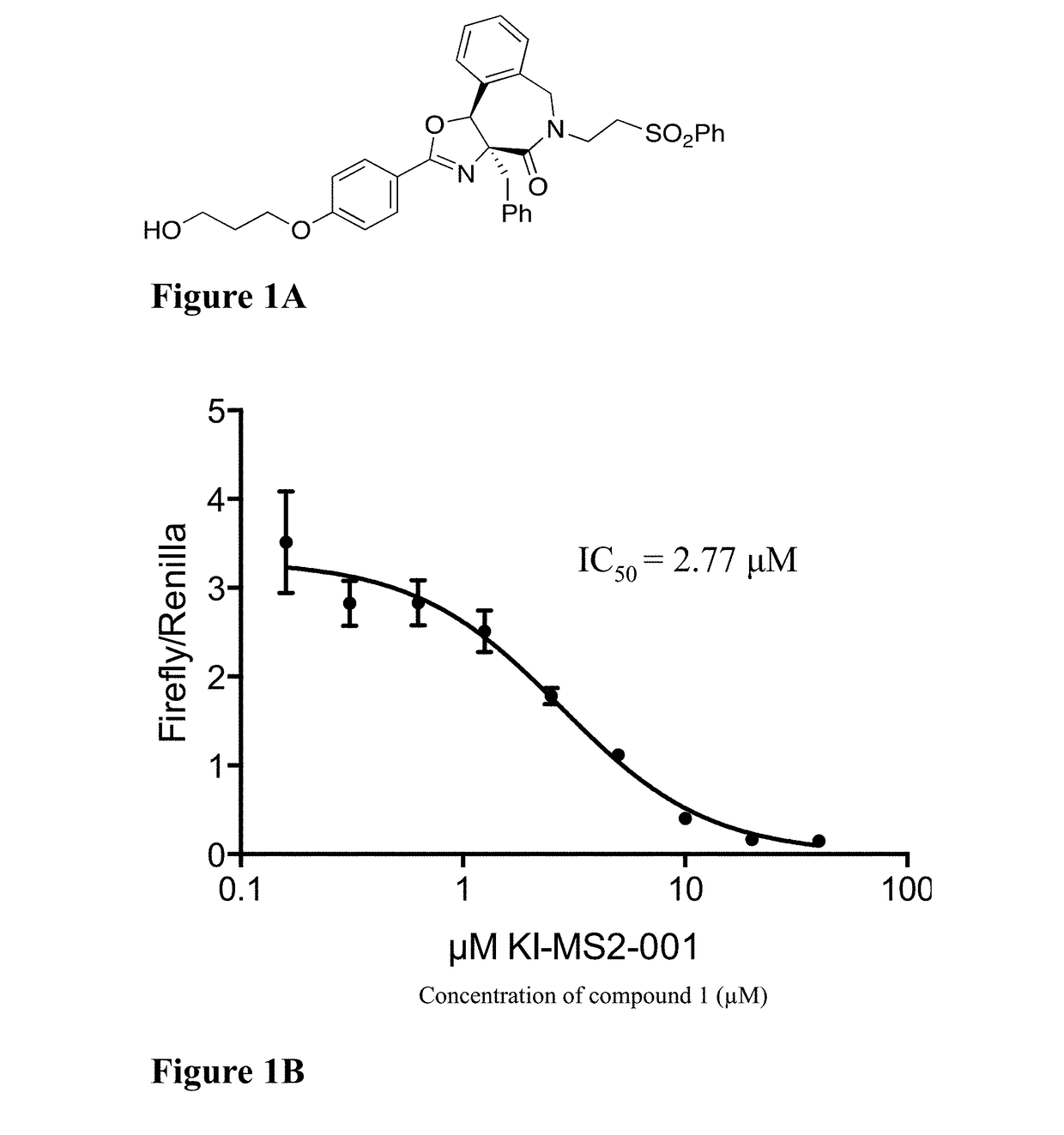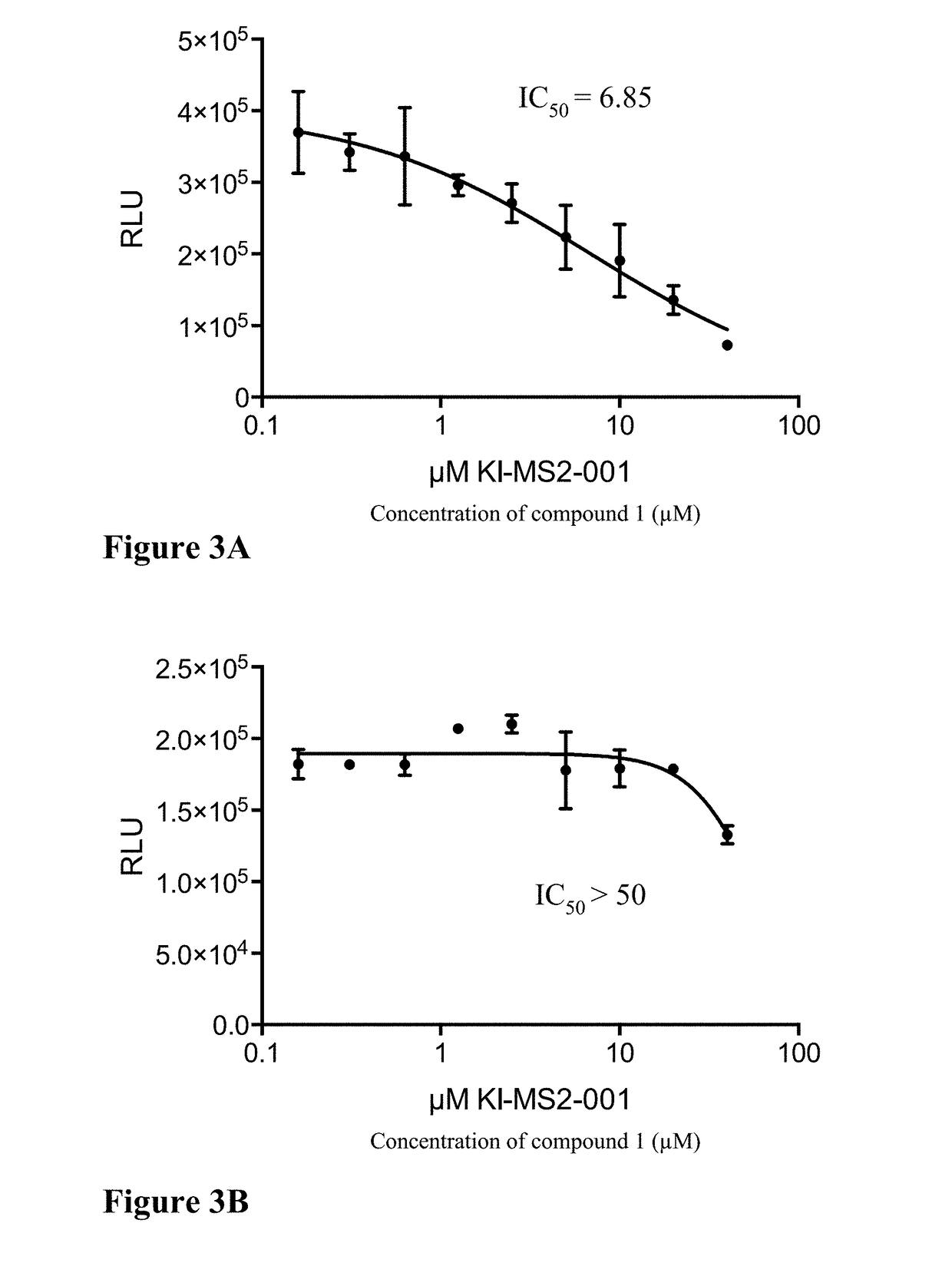Max binders as MYC modulators and uses thereof
a myc modulator and binder technology, applied in the field of max binders as myc modulators, can solve the problems of tumor regression, difficult to target myc protein using small molecule probes, etc., and achieve the effects of reducing or avoiding symptoms, signs or causes of the condition, and reducing or minimizing one or more symptoms
- Summary
- Abstract
- Description
- Claims
- Application Information
AI Technical Summary
Benefits of technology
Problems solved by technology
Method used
Image
Examples
example 1
orter Gene Assay of Exemplary Compounds Described Herein
[0435]Select compounds described herein that were SMM assay positives were evaluated in several versions of a c-Myc reporter gene assay, including a commercial assay from Qiagen. The compounds' activities against c-Myc were measured as a Firefly / Renilla ratio, using the Myc reporter assay (Qiagen) in HEK293T cells after treatment with the compounds for 16 hours. Exemplary results are shown in Table 2. Compound 1 was a potent inhibitor with an IC50 value of 2.77 μM (FIG. 1B and Table 2).
[0436]
TABLE 2IC50 values of exemplary compounds described herein in the c-Mycreporter assay and viability data in select cell lines. Viability was assessedby CELL TITER GLO assay (Promega). Results expressed asa mean + / − SEM (n = 3).c-MycreporterP493-6 Myc ONP493-6 Myc OFFassayViability in cellsViability in cellsCompound #IC50 (μM)(μM)(μM)cLogP 11.996.858.1— 29.34——— 34.7——— 55.38——— 64.67——6.9 711.34——— 81.25——— 92.74———101.62———114.29———137.88—...
example 2
ility Assay of Exemplary Compounds Described Herein
[0441]The effect of Compound 1 on cell viability in several cancer cell lines and normal human astrocytes (NHA) was determined. The cancer cell lines employed in the assay included those corresponding to Burkitt's lymphoma (ST486 and CA46), small cell lung cancer (NCI-H1963), and glioblastoma (GBM4). The cell viability of normal human astrocytes (NHA) was also assayed. Exemplary results are shown in FIG. 2, where viability was assessed by CELL TITER GLO assay (Promega). Compound 1 demonstrated an effect in cell viability in a variety of cancer cell lines, consistent with the notion that Myc is a key oncoprotein in a broad range of cancers. The effects of other compounds described herein on cell viability in several cancer cell lines were also determined, and exemplary results are shown in Table 2, where viability was assessed by CELL TITER GLO assay (Promega).
example 3
ty of Exemplary Compounds Described Herein for Cells Expressing Myc
[0442]The selectivity of Compound 1 for cells expressing Myc over non-Myc expressing cells in cancer cell line P493-6 (engineered cell line derived from human B-cells) was determined. Adding doxycycline to P493-6 growth media shuts off Myc transcription [9]. Exemplary results are shown in FIGS. 3A to 3B, where cell viability was assessed by CELL TITER GLO assay (Promega). FIG. 3A depicts the assay results for cells expressing Myc, and FIG. 3B depicts the assay results for non-Myc expressing cells. Compound 1 demonstrated a selectivity for cells expressing Myc and exhibited decreased cell viability, compared to non-Myc expressing cells in cancer cell lines. The selectivity of other compounds described herein in cancer cell line cancer cell line P493-6 was also determined, and exemplary results are shown in Table 2, where viability was assessed by CELL TITER GLO assay (Promega).
PUM
| Property | Measurement | Unit |
|---|---|---|
| density | aaaaa | aaaaa |
| molecular weight | aaaaa | aaaaa |
| diameter | aaaaa | aaaaa |
Abstract
Description
Claims
Application Information
 Login to View More
Login to View More - R&D
- Intellectual Property
- Life Sciences
- Materials
- Tech Scout
- Unparalleled Data Quality
- Higher Quality Content
- 60% Fewer Hallucinations
Browse by: Latest US Patents, China's latest patents, Technical Efficacy Thesaurus, Application Domain, Technology Topic, Popular Technical Reports.
© 2025 PatSnap. All rights reserved.Legal|Privacy policy|Modern Slavery Act Transparency Statement|Sitemap|About US| Contact US: help@patsnap.com



